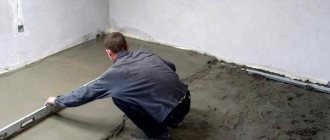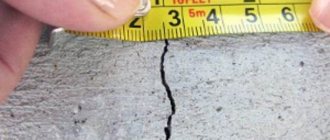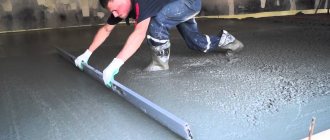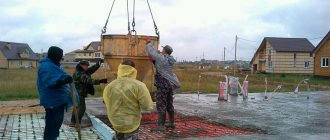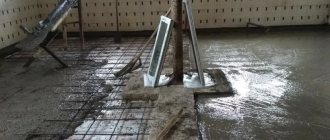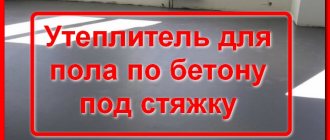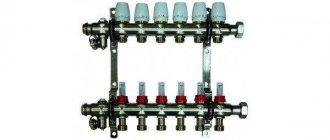The installation of warm water floors includes the installation of a concrete screed. The main requirement for a floor screed is sufficient density. This indicator completely depends on the brand of concrete. For heated floors, the recommended grade is 150-300.
The mixture for a warm water floor must be of high quality; it is important to know the technical characteristics of the components, the mixing technology, what the thickness of the mortar layer should be, and at what stage of floor construction it should be poured.
Preparatory work
Sometimes, when preparing the surface for screed, people do not pay attention to important details that, in fact, play a big role. The rough surface must be thoroughly cleaned of debris and small stones.
Before properly pouring a heated floor, a damper tape with a thickness of at least 40 mm is laid along the walls of the room in a circle. It is needed in order to prevent future cracks in the concrete layer from the effect of thermal expansion. The damper tape should not be neglected under any circumstances. Cracks in concrete will damage the heating system very quickly. It is necessary to make a heated floor cake on concrete according to all standards.
When the room area is more than 40 square meters. meters, or one of the sides is more than 8-9 meters, the concrete coating must be divided into zones using thermal joints. To do this, use a T-shaped damper tape. It is laid before concrete work begins. Each zone must have its own heating circuit; this should be designed in advance.
Sometimes builders lay reinforcing metal mesh on top of the insulating board. If the heat insulator is durable and the load on the heated floors is not very large, such a mesh can be ignored. The mesh is attached to the concrete through a layer of insulation. The water circuit is twisted with mesh rods. This method is convenient, but not justified in all cases. If the reinforcing layer is laid directly on the heat insulator, the mesh will not withstand the vertical pressure on the floors. It will perform a single function - convenient fixation of the water pipeline.
When using durable insulation (foam glass), the situation will be different. If soft insulation (foam plastic) is used, the screed must be additionally reinforced. Reinforcement, which is placed on top, and not in the concrete itself, neutralizes only horizontal deflections. To prevent the formation of splits, the mesh is placed closer to the center of the concrete covering, above the pipes.
Sometimes they use an option where two meshes are laid: on top of the pipes and under them.
There is another way using one grid. It is raised above the heat insulator by 15-20 mm using pads. The pipes are laid on top.
A screed where the water circuit is completely embedded in concrete will be stronger. But the cost of constructing a heated floor is increasing. The total thickness of the concrete layer will be 20-30 mm greater.
Before starting concrete work, water should be poured into the circuit, creating working pressure in the pipes. Sometimes they use compressed air. It is prohibited to heat the pipes.
Is it possible to fill a heated floor with concrete?
In principle, we have already answered this question in the introduction, but we need to make a small clarification. There are several types of underfloor heating: for example, heating mats, flooring systems, water pipes and electrical cables. Their operating principle is approximately the same. Heating is carried out either by circulating hot water through laid channels, or by electric current. The difference lies in the installation features of these structures.
Without going into installation details, let's say that a screed is only necessary for water pipes and electrical cables. Here, concrete not only protects the system from mechanical damage, but also participates in heat exchange processes. In other cases, the floor covering is laid directly on the heated floor, without pouring a screed.
A mixture of cement and sand
How to properly fill the floor under heated floors with a water circuit? The most common type of screed is made of cement and sand. It is easy to work with; sand particles act as an excellent plasticizer.
Typically, for concrete work in living rooms, cement-sand mortars of grade 150 are used. For installing a water floor, it is recommended to use M200. With increased loads on the floors, you can use a higher brand:
- M200-M250 when installing floors in retail premises or public buildings;
- M300 is used in warehouses and garages.
Factory mixtures, which will be delivered to the repair site, are purchased at mortar units. In stores they are packaged in bags. You can make the mixture yourself. This is a more labor-intensive way, but economical. You need to maintain the dosage of the components and find river sand with a coarse fraction.
Cement-sand mixtures for damp, wet rooms (bathrooms, swimming pools) are made with M400 cement. M500 cement quickly gains strength and is suitable for rooms with dry floors. The recommended thickness of underfloor heating screed is about 40 mm. In this case, laying a water-heated floor in a screed will be carried out without difficulty.
How to properly fill a warm water floor so that it lasts a long time? It must be resistant not only to mechanical, but also to thermal stress. It is recommended to add polypropylene fiber to the solutions: 900 grams per 1 cubic meter. The cost of such an additive is small, but it will increase the level of strength of the screed and prevent the appearance of small cracks. You should be aware that the fiber additive does not replace the reinforcing mesh.
Types of screeds for heated floors
There are two of them: wet and semi-dry screed. Let's figure out how they differ and which one is better.
Wet screed
This is the most common concrete. By the way, many people unknowingly call concrete any mixture that contains cement, water and sand. In fact, one should distinguish between concrete and the so-called cement-sand mortar, or CSP. Real concrete always contains coarse aggregate – usually crushed stone or gravel. If this component is missing, then we are talking about a regular solution.
As a rule, DSP has less strength and is not used in critical work (for example, when pouring the foundation of a house). However, the absence of coarse aggregate in the solution also has its advantages: such a mixture is easier to prepare and lay, and the surface of the screed is very smooth.
To install a wet screed, you can order the delivery of ready-mixed concrete at the factory or prepare the mixture yourself. True, in the second case it will be problematic to achieve ideal proportions.
Among the advantages of this type of screed are:
- Optimal cost
- High heat transfer
But there are also disadvantages:
- Quite a large weight of the structure
- Labor intensity of pouring
- Long term concrete strength gain (up to 28 days)
Semi-dry screed
It is a mixture of sand and cement with the addition of a minimal amount of water. Most often, semi-dry screed is sold ready-made and delivered to the customer’s site using pneumatic blowers. Then it is laid and processed with a trowel. The result is a perfectly flat surface on which the flooring can be installed almost immediately.
Advantages:
- Light weight design
- Rapid strength gain (after 24 hours you can walk on the screed)
- Less dirty work compared to pouring wet screed
Flaws:
- High cost (4-5 times more expensive than a conventional screed device)
- Low density and, as a result, worse heat transfer
- Requires special equipment (pneumatic blowers and trowels)
Sometimes a third type of screed is mentioned - dry. It is a compacted layer of expanded clay on which the flooring is laid. But this type of tie is not used for water pipes and electrical cables. Expanded clay has low thermal conductivity, so the system will not work effectively with it.
In recent years, the semi-dry variety of screed has become increasingly popular. A construction team can lay up to 100 square meters of such covering in one working day. At the same time, you will not need to wait a whole month for the concrete to gain strength: installation of floors can begin in 3-5 days. On the other hand, the high cost of semi-dry screed and the inability to lay it yourself force in most cases to give preference to traditional pouring with concrete or a cement-sand mixture. It is this option that we will talk about in the continuation of the article.
Screed from dropouts
If you pass crushed stone through a construction sieve, you will get a fraction of particles up to 1 cm in size. This is screening. It is similar to sand with a coarse fraction, but the grains of sand are round in shape, while the particles of screenings are chipped, with sharp edges. This structural feature significantly increases the strength of the mortar compared to sand. This solution is more difficult to install, but the effort is ultimately worth it.
A warm floor under a solution with this composition is reliable. You can save money by using the M150 mixture. No fiber need to be added.
The inconvenience is that it is difficult to find a concrete layer from screenings at mortar units. Large fractions may be present in the purchased solution. This will significantly complicate the process of leveling the screed. Pebbles larger than 2 cm are acceptable according to GOST, so manufacturers produce such a solution in accordance with the standards.
If you are concerned about the question of how to properly fill a heated floor in a house, it is more advisable to prepare the solution using a home concrete mixer, using fine screenings.
By lighthouses
If the room is large, then beacons must be installed before pouring the heated floor. They represent levels - guidelines, based on which you can level the screed.
Types of beacons for heated floors:
Pin. Usually these are self-tapping screws on dowels. Pin beacons are suitable for semi-dry screeds and self-leveling floors. Their length should be 2-3 cm greater than the estimated height of the screed.
Beacon self-tapping screws are installed one for every 1-3 m2 and connected with a fishing line, which should be located exactly at the level of the future leveling layer. After this, the composition is poured. When the work is completed, the beacons are unscrewed so as not to damage the screed.
From mortar piles. To make such beacons, use the same solution as for pouring. Their height should also slightly exceed the expected level of the screed. They are most suitable for working with wooden bases, since they do not harm the insulating layer.
Mortar piles are placed along pre-marked lines. The outer rows retreat from the wall by 30 cm, the step to the adjacent rows is 1 m. The heaps located in the same row are spaced 30-50 cm apart. The beacons are given a day to harden, after which they are covered with a primer and the screed begins to be poured.
Linear. They are made from metal profiles, drywall, slats, boards, etc. This type of beacon is used more often than others. The rules for their installation do not differ from those described above. The only difference is that a number of small elements are replaced by one large one. When all the landmarks are placed, all that remains is to fill the screed.
After laying out the solution, you need to level it using the following rule: place the tool on the guides and pull it towards you, moving it slightly from side to side. After a day, the profiles are removed and the holes are sealed with a primer or mortar.
Attention! If the screed is dry, then there is no need to remove the profiles.
Self-leveling solutions
You can use a self-leveling mixture to screed a warm water floor.
This building material is not cheap. Labor costs are noticeably reduced. Simply add water to the dry mixture, stir, pour it onto the floor and you don’t need to do anything else. The mixture will even out on its own.
The advantage of self-levelers is the harmoniously selected components of the solution, mixed in the factory. The mixture is already enriched with the necessary additives and plasticizers.
The finished leveling solution is poured onto previously prepared floors and stretched over the beacons. If you follow the manufacturer's recommendations, you will get a durable surface that is resistant to temperature changes.
There are some subtleties that you should know about before purchasing a self-leveler. It sets very quickly, and you will need a lot of solution. If you fill the floors in small bathrooms, then there will be no problems. The mixture can be stirred with a drill mixer. But how to quickly mix, at one time, a cubic meter of solution for a room of more than 20 square meters? This is impossible to do in a regular trough. If you fill it in parts, in layers, the quality characteristics will deteriorate. To make such a solution, you need special equipment, a compact mortar mixing plant.
In order to fill large volumes, you can buy or rent such equipment. But under normal conditions, for apartment renovation, this is impractical. The self-leveler will still have to be leveled manually.
Such a solution will pay off on site if you have an unlimited budget. Or when laying heated floors in a small area. There are brands of self-leveling that can be laid in a thick layer. You should know: despite the fact that such a solution sets quickly, it reaches “standard” within 7-15 days, no less.
Rough preparation
A warm floor is formed in several layers:
- Rough screed;
- Sound and heat insulator;
- Heating elements;
- Finishing screed (upper part of the structure).
The rough layer is leveling. It is not required if the base is a flat floor slab, like in an apartment. In a private house, floor heating is often installed on the ground; in this case, a self-leveling solid foundation is necessary.
To properly fill, you need the following materials:
- dry mix or cement mortar;
- reinforcing composition (can be replaced with a reinforcement mesh with medium-sized cells);
- waterproofing and insulating materials;
- fasteners;
- container where the solution will be mixed;
- construction mixer (can be replaced with a drill if you have a suitable attachment);
- putty knife.
Subfloor
Installation technology
Before pouring the solution:
- Make sure that the temperature at the work site is between + 5°C and + 25°C.
- Clean the working surface (the presence of debris will impair the adhesion between the solution and the base);
- Repair all cracks in the base;
- Line the perimeter of the wall with damper tape to the depth of the screed;
- Install level beacons.
After this, you can move on to the main part of the work:
- Prepare the mixture;
- Fill it, strengthening it with reinforcing mesh if necessary;
- Wait 24 hours, cover the dried concrete with polyethylene;
- After a week, remove the film (further hardening will occur without it).
Expert opinion
Sergey Permyakov
Heating systems engineer
The minimum thickness of the rough screed must be at least 3 cm ; a thinner layer will crack and collapse. There is no point in pouring more than 5 cm under a warm floor; exceeding this limit will lead to a noticeable reduction in the volume of the room.
You can start the next stage of work in a week . The strength of the screed will be about 70%, this is enough to withstand the load. It will take 28 days for the base concrete coating to dry completely. During this time, concrete gains 100% strength.
How to fill with a “wet” screed
If a lot of water is added to the solution, you get a “wet” screed. The solution will be plastic.
The component ratios are as follows:
- When laying heated floors in a dry residential area, an M200 solution using M500 cement is suitable. You will need 1 part cement, 3 parts sand and 1-1.4 parts water.
- When laying heated floors in a damp room (in a bathroom), you need an M200 mortar based on M400 cement. Take 1 part cement, 2.5 parts sand and 1-1.4 parts water.
- In reality, the volume of liquid depends on the moisture level of the sand and the amount of dust in it. In this regard, water is added gradually, mixed and plasticity is controlled. The result should be a mixture similar to thick sour cream.
- The solution is leveled between the pipes and compacted, removing air bubbles.
Metal-plastic pipes can become deformed if you walk on them. Polyethylene is more durable in this regard.
The process of leveling the mixture is facilitated by a long rule and pre-placed beacons. The recesses are filled with the mixture and leveled again.
The screed is made from the screenings in the same way. But everything is done more carefully, more labor will be required. The advantage of the “wet” method is the plasticity of the solution, which is easy to level with a rule.
Brand of concrete for underfloor heating screed
Some builders recommend using concrete class B22.5 (corresponding to grade M300). It is capable of withstanding pressure up to 325 kg/cm2, and its frost resistance reaches grade F200 (up to 200 freezing/thawing cycles without loss of quality).
To more clearly explain what kind of material this is, it is enough to mention this fact: B22.5 concrete is used for pouring the foundations of multi-story buildings and as road surfaces. Let us also clarify that the density of finished structures from this brand is 1,900-2,500 kg/m3. A 10 mm screed with an area of 6 m2 will weigh up to one and a half tons.
The disadvantages of B22.5 concrete include poor workability. Due to its low plasticity, the solution requires careful compaction. Otherwise, there will be voids in it that can destroy the screed. On the other hand, intensive compaction can damage the pipes and cables of the heated floor, which is also unacceptable.
In fact, using such strong and dense concrete to screed a heated floor is in most cases impractical and unprofitable. It makes sense to use the M300 brand only in rooms where serious loads will be placed on the coating - for example, in a garage.
Now let's look at other brands of concrete that are suitable for pouring heated floor screed.
Concrete B3.5 (M50)
This is the lowest grade, so its use in construction work is very limited. It is not suitable for installing a full-fledged screed: it can only be used to level the surface for laying the floor covering.
Concrete B10 (M150)
This material has a low cost due to its low cement content. This brand does not withstand heavy loads, but can be used for pouring heated floors in small rooms (bathroom or kitchen). Due to its relatively low density, such concrete has good thermal conductivity.
Concrete B15 (M200)
This brand is optimal for most residential premises. The screed can withstand loads of about 175-225 kg/cm2, and this is enough to install a heated floor in an apartment or private house. For basements, garages and other outbuildings, it is better to choose a higher grade.
As you can see, B10 or B15 concrete is mainly used for screeding. These two varieties have good quality and reasonable cost. If the floor will be exposed to serious loads of more than 500-600 kg, it would be more advisable to use B20 (M250) or B22.5 (M300) concrete.
Our own concrete production and laboratory, as well as a large fleet of equipment guarantee high quality products and accurate delivery times
Concrete - production and delivery
Concrete pumps - rent
Read more about us here
7 904 179–31–56
Valentin Yurievich Shvets
Director of BetonStroy
"Semi-dry" method
There is much less water in the solution for the “semi-dry” method. If the mixture is made correctly, it will be moist but not runny.
They check it this way: squeeze a little semi-dry solution in your palm. It should form into a plastic lump without cracks. This is the consistency of a factory-made solution. It is more difficult to level, but then you can rub it to a shine, and ultimately get a surface that is dense and durable in structure.
If you order such a solution ready-made, you need to explain for what purposes it will be used. This concrete layer can withstand heavy loads. It is of higher quality than when laying concrete using the “wet” method.
You will have to rub it very carefully; this requires skill and patience. You will need a long grater or trowel. Semi-dry mixtures from screenings are practically not amenable to smooth grouting, so it is ground with sandy mortar.
Plasticizer is an important component of screed
It is recommended to use a plasticizer as part of the screed. Its use will have only a positive effect on the design:
- The setting time is significantly reduced.
- Low pressure is created with each subsequent batch.
- If the mixture has a low cement to water ratio, the hardening period will increase and the setting process will slow down.
- The use of a plasticizer will make it possible to achieve hydraulic self-compacting concrete with great strength.
The use of a plasticizer occurs in several stages:
- The plasticizer is added immediately with all the components that are included in the solution. All components should be thoroughly mixed in a concrete mixer. The result is a homogeneous mixture.
- The prepared solution is poured into the designated area. The most important thing at this stage is to evenly distribute the suspension over the entire surface of the area being poured.
- After two weeks, you can put furniture on the surface, and after another week you can walk.
How to properly lay a “semi-dry” concrete screed
In order for the concrete layer to be perfectly smooth, you need to position the beacons correctly. The distance between the beacons is left such that the one and a half meter rule can be used. That is, a distance of no more than 140 cm should be maintained between the beacons.
Types of beacons:
- Mortar beacons made of narrow ridges of cement-sand mortar (gypsum cannot be used). Not the most effective method, since the ridges must dry out, and this takes time. In addition, a rule can accidentally “knock down” such pointers.
- Lighthouses made of metal pipes. Pipes or other rigid profiles are strengthened at the required height. A day after laying the concrete, they are removed and the recesses are filled with mortar. Pipes are used several times for this purpose. The only condition is that they must be perfectly even. Both round and rectangular profiles are used.
- Galvanized guides for plaster. The stronger the beacons, the better. The optimal size is 1-1.4 cm. After they have performed their function, they can be left in place or removed after the solution has set. Such beacons are disposable. If you have the skills, you can set them as evenly as possible. Strengthen with mortar, adjusting it to the level using a piece of tile or a brick fragment. The distance between the beacons is 40-50 cm. Sometimes they are installed on special supports that can be adjusted.
On wooden floors
To fill a wooden house, you need to perform the following steps:
- Carefully inspect the covering (replace damaged joists, and turn over partially damaged joists);
- Add support beams (if the logs are installed in increments of 40 cm);
- Recess the nail heads into the boards by 2-3 mm (otherwise they will later tear the insulating film);
- Seal the gaps at the junction between the walls and the floor with thin boards (they are removed after pouring, which ensures ventilation of the base and does not allow it to rot);
- Eliminate deep and small cracks;
- Remove debris and dust, sand the base if necessary;
- Prime wooden surfaces (this will ensure their moisture resistance);
- Cover the bottom of the wall with damper tape (10-20 mm thick and 2-3 times thicker than the screed) to cut off its surface from the cement;
- Ensure waterproofing of the base using an intact polyethylene film (its individual parts are overlapped by 10 cm, the overlap on the walls is 20 cm, all tears and punctures are sealed with tape).
Option for installing TP on wooden logs
Attention! It is not recommended to fill if the wooden floorboards are fresh. They can become deformed under the weight of the screed.
What thickness should the screed be?
To understand what the thickness of the concrete screed for water heated floors should be, the following points should be taken into account:
- The concrete layer should not interfere with thermal radiation. The water circuit must perform its function.
- In order for the screed to be strong enough, the thickness of the self-leveling compound should not be less than 2.5 and 4.5 cm.
- The thickness of a regular concrete layer reaches 6-7 cm.
- In total, the thickness of the water heated floor will be 15 cm.
- If you increase the thickness of the screed, this will lead to the risk of splits in the concrete layer. To prevent this from happening, it is necessary to provide expansion joints.
Brands
When choosing a dry ready-mix, you should give preference only to high-quality products. There are well-known brands that have proven themselves on the positive side. These include the following companies.
Knauf
The UBO Knauf cement-based mixture using granulated polystyrene foam has good thermal insulation and soundproofing. It is used as a universal solution that does not require additional coatings.
Boden Knauf's gypsum-based mixture using polymers allows you to create very thin surfaces from 2-15 mm. Thanks to these mixtures, it is possible to level out unevenness reaching 35 mm in height (even 80 mm).
- For roughing, Boden 30 mixture is suitable.
- Boden 15 is used as a self-leveling product based on gypsum with the addition of plasticizers.
- For universal processing, use Boden 25 on a gypsum basis with the addition of mineral components.
Ceresit
The CN 80 mixture is used for rough processing. The universal building mixture marked CN 175, CN 76, CN 88, Tomsit DG does not require additional coatings and dries very quickly. CN 68, Thomsit D, Thomsit DD is used as self-leveling. Levels substrates up to 60 mm thick.
"Osnovit" "Staroline T-41", "Mixline T-44" are universal mixtures. Level surfaces up to 150 mm thick.
Grupa Altas
The mixture “Typhoon Master No. 44, No. 45” is suitable for initial surface treatment.
- The mixture “Typhoon Master No. 41, No. 48” is used as a self-leveling mixture.
- "Typhoon Master No. 40, No. 47" is used as a universal mixture.
"Sarmat"
Mixtures “Optimal”, “Sarmat NV-42”, “Sarmat NV-40” are suitable for primary treatment of bases with large uneven areas.
- The Sarmat NV-45 mixture can be used as a self-leveling mixture.
- "Sarmat NV-43" is used as a universal solution.
Unis
The “Horizon” mixture is suitable for the initial treatment of bases with large uneven surfaces, and “Horizon-2” is used as a self-leveling mixture. “Horizon Eco-Pol” is used for universal floor treatment.
Bergauf
Base and Easy Boden mixtures are suitable for the initial treatment of bases with large uneven surfaces. Boden Inter Gross is used for universal surface treatment.
Ilmax
The ilmax X-plan mixture is used as a self-leveling mixture, and Ilmax 6600, Ilmax 6650, Ilmax 6705 gypsplan, Ilmax 6715 rapidplan are used as universal floor coverings.
Compositions based on well-known brands have similar components, but differ only in the type of sand. Small grains contribute to the formation of a more liquid consistency. The type of initial surface determines the use of a particular brand.
Universal products are convenient because they do not require additional coatings. However, their use requires special qualifications and knowledge. It is better to purchase the mixture in large stores.
Please pay attention to the release date. The earlier it was released, the worse the quality
Caring for wet screed
After the concrete layer is poured, the screed requires maintenance. The room temperature must be maintained at least 5 degrees above zero. The screed must not be allowed to dry out. A day after installation, it is covered with plastic film. The concrete needs to be moistened from time to time for about a month. The strength of concrete depends on this. You can begin installing the water circuit for heated floors no earlier than 28 days later. All this time, the working pressure must be maintained in the pipes, but the heating cannot be turned on.
Video description
In this video you will see the secrets of good screed pouring: The mixture is laid out in small slides. A shovel is used to level them. Pouring a heated floor with a perfectly flat surface is not always possible. Therefore, in order to achieve this result, the solution is laid above the established profile. The next morning they come and remove the excess. But you don’t need to wait until the mixture hardens completely. It should harden a little.
Upon completion of the work, they begin to remove the guide profiles. The places where they were are treated with cement mortar and leveled.
Finally, a small amount of water is applied to the surface and covered with a polyethylene film. This will prevent the base from cracking. To prevent the floor from drying out too quickly, it needs to be moistened for at least 3 days.
Preparation
To make the floors wear-resistant, it is best to use M400 or M500 cement when preparing the mortar. As for the added sand, it should have large grains, approximately 0.8 mm in diameter. This will protect the surface from the appearance of cracks and other defects. The fine fraction of sand used for bricklaying is not the best option. When installing a warm water floor, a thickness of at least 20 mm will be required, depending on the type of screed. Use the concrete volume calculator to determine the quantity.
There is one nuance that allows you to eliminate the liquid solution - adding water in portions. The important thing here is to eliminate the possibility of using too much water.
Dry cement mixtures M300 sand concrete are presented in finished form. Here you no longer need to think about proportions and getting a quality fill. Dry mixtures can only be diluted with the required amount of water, which is prescribed in the instructions from the manufacturer. Separately, it is very difficult to obtain all the required components of the semi-dry mixture for pouring a warm water floor. For this reason, it is better not to experiment, but to buy a ready-made version for installation.
Each type of mixture can be accompanied by plasticizers that can give the final solution more qualities and characteristics. In any case, even if they are included when purchasing, you should adhere to the mixing options indicated on the package. If it is difficult to decide which mixture to choose for underfloor heating screed, it is better to seek help from specialists or company representatives.
What you need to fill the floor
The work can be done efficiently if you have the following tools at hand:
- beacons (steel pipes, slats, aluminum profiles);
- building level;
- roulette;
- stationery knife;
- roller (needle or regular);
- rule;
- drill;
- concrete mixer, mixer;
- metal brush;
- spatulas;
- reinforcing mesh;
- fastening material;
- brushes;
- container for mixing the solution.
Use professional flooring tools.
T-shaped aluminum profiles, which are left in the coating after the solution has hardened, can act as beacons. Steel pipes with a diameter of 7 cm are also suitable.
Floor screed plays an important role and performs several functions.
To understand in what proportions to prepare the mixture, you will need to calculate the screed per 1 square meter. The final numbers will depend on the selected components.
Known methods of mixing mortar for floor screed require precise calculations.
When choosing ready-made mixtures, you don’t have to worry about calculating additional materials, since everything is taken into account in its composition
It is important to read the composition of the product, since ready-made mixtures have different characteristics. The packaging provides complete information for calculating consumption
They often write on the packaging how to prepare a solution from the mixture.
Standard proportions of cement mortar are 1:3. This means that 1 bucket of cement requires 3 buckets of sand. This option is chosen for most types of work.
Why and how to prime the screed
Impregnating compounds are designed to bond the top finishing layer. A deep penetration primer impregnates the floor by 1-2 cm. A penetrating primer eliminates situations in which the upper part of the screed comes off as a result of thermal expansion, especially if the surface was additionally leveled using leveling mixtures.
The primer helps to hold all the screed components together and prepare the base for future flooring installation.
It is especially important to treat the surface with a primer when installing ceramic tiles. The adhesive composition has low adhesion to dust and debris. At a screed temperature of 25°C, the tiles will begin to move away from the unprimed surface within a few months.
Laying technology
The process of pouring a floor slab may differ for rooms of different purposes and layouts. The general scheme for laying the screed consists of several stages:
- cleaning the floor up to cleaning the concrete base;
- filling the leveling screed. If the floor slab is uneven in thickness, it may collapse prematurely due to temperature changes across its volume;
- laying a film (prevents the solution from leaking to the lower floors) and a layer of foam plastic (increases the efficiency of heat transfer to the upper part of the floor). A heat-insulating (reflective) film is sometimes placed on top of the foam;
- installation of the selected heating system;
- pouring a solution prepared in advance. Expansion joints must be provided between the walls and the screed to compensate for cycles of expansion and compression. For the same purpose, intermediate shock-absorbing seams are laid in a large room.
Read below about the brand of mortar for underfloor heating screed.
Finish filling on TP
If the rough screed has dried, it’s time to move on to the next steps:
- installation of a heat insulator. Thermal insulating material is mounted only on a clean base (it is best to vacuum it). The heat insulator can be cork, foam, polypropylene, aluminum foil or metallized Mylar film. To secure it, tape, dowels and glue are used.
- Laying damper tape. The damper tape protects concrete from cracking associated with temperature fluctuations. Mounting area: along the perimeter of the room and between the contours of heated floors.
- Laying heated floor elements. Pipes need to be checked for breaks (especially at bends), and when running cables, grounding must be ensured.
- Reinforcement. Reinforcing mesh can be placed under the pipes, above them, or in both places at once. Pipes are easily attached to the lower metal mesh during installation, however, unlike the upper one, it does not provide reinforcement for the screed. If the concrete is of high quality, then this part of the work can be abandoned.
- Pouring finishing screed. Before proceeding to the last stage, you must check how well the heating system is functioning. The screeding solution is poured at above-zero temperatures and in one go. Partial filling is allowed only in rooms with a multi-level floor. The concreting process begins from the far side of the room and ends next to the door.
Pie TP
After finishing the pouring, it is recommended to make several punctures in the coating with a metal knitting needle or similar object. This will prevent the formation of voids.
In the next week, the concrete surface should be moistened with water 2-3 times a day. This will prevent it from drying out while it hardens.
The thickness of the finishing layer can be from 3 to 7 cm in a private house, and in an industrial area - 10 cm.
If a water heated floor is installed, the height of the screed above the pipes should be 3.2-7 cm.
Read more in the article.


